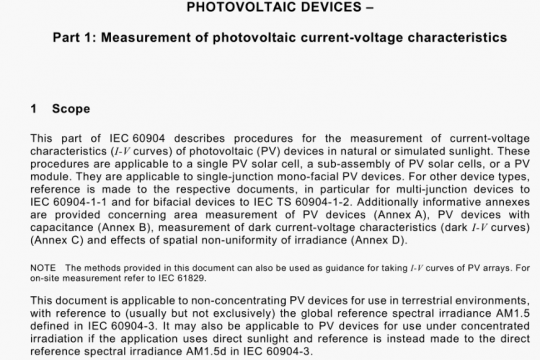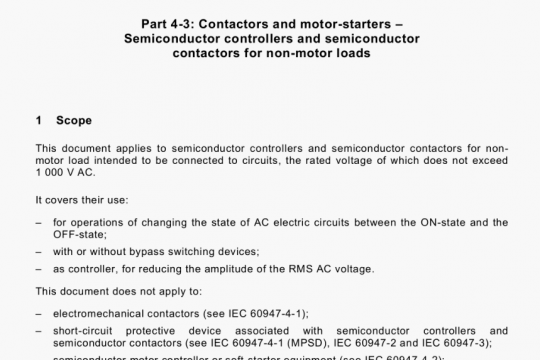IEC TS 63297-2021 pdf free
IEC TS 63297-2021 pdf free.Sensing devices for non-intrusive load monitoring (NILM) systems.
A NILM sensing device (NSD) is a device connected to the electrical installation. It produces data that can be used by NILM analytics. Examples of data that may be produced by an NSD include:
— samples of current and/or voltage waveforms;
— features characterizing the current andlor voltage waveforms;
— features related to the high-frequency patterns in the electrical signals;
— estimated values of electrical parameters;
— measured values of electrical parameters.
4.3 NILM analytics
The value of NILM systems is essentially in the analytics and how well they are able to make use of the data produced by the NSD.
NILM analytics are algorithms that analyse the data output by an NSD and produce estimated disaggregated information that can help stakeholders make decisions.
Examples of information that may be produced by NILM analytics are:
— estimated disaggregation of energy consumption into specific usages (heating, refrigeration, entertainment…);
— estimated disaggregation of energy consumption into specific types of appliances (ovens, fridges, pumps…).
NOTE NILM systems produce estimated disaggregation into energy usages. When accurate measurement and analysis of energy consumption andlor other electrical parameters is needed (e.g. for monitoring the electrical installation), systems based on standardized measuring devices (e.g. PMDs or meters) are used.
5 Classification of NILM sensing devices (NSD)
5.1 General
A NILM sensing device (NSD) is a gateway between the physical electrical installation and the world of analytics. In order to operate efficiently, NILM algorithms need to know the type of data they are to process. The behaviour of the NSD depends on several characteristics (see Figure 3).
5.2 Definition of NSD classes
NILM sensing devices should be classified according to a limited number of essential parameters, for example:
— Input sampling frequency: the frequency at which the electrical signals are sampled by the NSD. This frequency typically varies from a couple of kHz to the MHz range. The sampling process may be gapless or not.
This parameter is essential to characterize NSDs that produce samples of the electrical waveforms. It is less relevant for NSDs producing estimated or measured values; therefore a separate class is specified (class P as parameters only).
— Output rate: the rate at which the NSD produces data that can be used by NILM analytics. This rate typically varies from one set of data per second to one set of data per 30 minutes.
— Data bit rate: the average bit-per-second (bps) over an hour at which the electrical signals are quantified by the NSD. This data bit rate typically varies from a few bps to the Mbps range.
Table 1, Table 2 and Table 3 provide a classification of NILM sensing devices according to these three parameters.IEC TS 63297 pdf free download.




